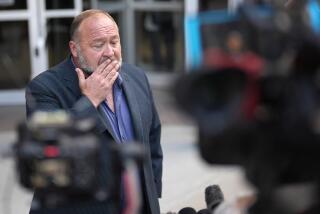Liquidation Plan for American Continental OKd
A federal judge in Phoenix approved a plan on Friday to liquidate bankrupt American Continental Corp. and to pay creditors $21 million from its former subsidiary, Irvine-based Lincoln Savings & Loan.
About $14.6 million of that payment is earmarked for American Continental’s largest creditor group, those who purchased American Continental bonds primarily at Lincoln branches in Southern California. That payment to bondholders represents nearly 6 cents for each dollar they lost in the company’s bankruptcy.
But should the bondholders eventually recover damages through pending lawsuits, they would have to reimburse Lincoln for the $14.6 million. They are suing former executives at American Continental and the company’s legal and financial advisers, claiming that they were misled into purchasing the bonds.
The liquidation plan was approved by U.S. District Judge Richard M. Bilby, who is presiding over all civil and bankruptcy proceedings. The plan is expected to be confirmed by Bilby next week and would go into effect 30 days later.
American Continental currently has $340 million in debts and about $6 million in assets. The company will seek recovery of up to $29 million through lawsuits it plans to file, said M. Freddie Reiss of Price Waterhouse, the accounting firm representing the unsecured creditors committee.
The liquidation plan sailed through the court proceeding with no objections from Charles H. Keating Jr., former American Continental chairman, or anyone else.
The plan ends eight months of bargaining among the unsecured creditors committee, lawyers for the bondholders and the Resolution Trust Corp., the federal agency that manages Lincoln and other insolvent S&Ls.;
“This was hard-fought,” said Donald Gaffney, attorney for the unsecured creditors committee. “The appearance in court with all objections being withdrawn reflected the fact that the fighting was done before then.”
Gaffney said the objections to the plan by American Continental, Keating and other former executives and the company’s former accounting firm, Arthur Young & Co., were settled shortly before the hearing began.
“Approval of the plan gets all the potentially difficult bankruptcy issues behind us and allows us to go forward to trial with our class actions,” said Mark K. Worcester of Orange, a lawyer representing the 23,000 bondholders.
He said a separate agreement with the RTC, also approved by Bilby, will help both the agency and lawyers for the bondholders pursue Keating and others for damages. The two sides already are sharing confidential information, Worcester said.
But approval of the plan also means that investors who purchased $250 million in corporate bonds--the biggest chunk of American Continental’s current debts--will likely get nothing further from the liquidation of the company, Worcester said, and must seek recovery through litigation. Nearly all the remaining creditors stand ahead of the bondholders in bankruptcy in recovering funds.
American Continental filed for bankruptcy protection on April 13, 1989, and federal regulators seized Lincoln the next day. Regulators now predict that Lincoln will cost taxpayers about $2 billion, making it one of the nation’s costliest thrift failures.
On Friday, Bilby also removed final objections to two pending settlements totaling $24.3 million between the bondholders and two law firms that helped gain regulatory approval for the bond sales.
The $14.6 million that bondholders get from the liquidation payment along with the funds from the settlements would give them 18 cents on the dollar.
More to Read
Inside the business of entertainment
The Wide Shot brings you news, analysis and insights on everything from streaming wars to production — and what it all means for the future.
You may occasionally receive promotional content from the Los Angeles Times.










